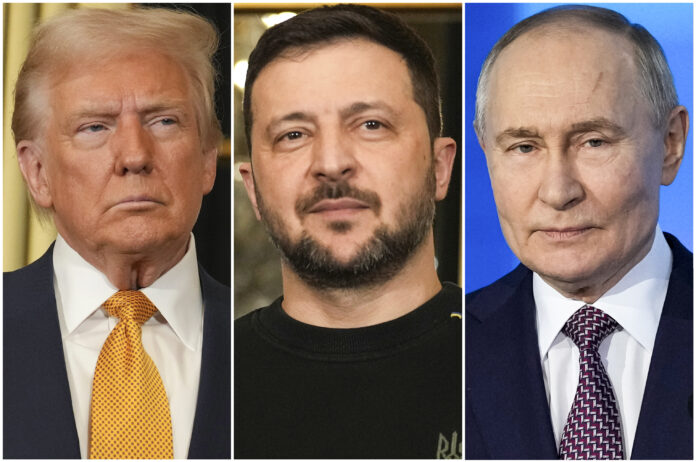- Russia dismisses Trump’s 50-day ceasefire ultimatum, calling it unacceptable and vowing to continue the war until its objectives are achieved.
- Trump threatens 100% tariffs on nations trading with Russia, urges NATO allies to fund weapons for Ukraine, and expresses frustration with Putin.
- Zelensky welcomes U.S. support, but peace remains distant as Russia demands recognition of occupied territories, a deal Ukraine refuses to accept.
Russia has slammed former President Donald Trump’s latest call for an end to the war in Ukraine, brushing off his 50-day deadline for a ceasefire as unrealistic and “unacceptable.” Tensions surged after Trump vowed to punish nations doing business with Moscow if President Vladimir Putin doesn’t agree to halt the war within that time frame.
The Kremlin’s swift rejection added another layer of friction to an already volatile global standoff, with Russian officials doubling down on their goals in Ukraine and showing no signs of yielding to Trump’s pressure.
Moscow Brushes Off Trump’s Threats, Stands Firm on Ukraine Goals
On Tuesday, Russian Deputy Foreign Minister Sergey Ryabkov took center stage in dismissing Trump’s demand. “We don’t respond to ultimatums,” Ryabkov told Russian state media. “Diplomacy remains our preferred path, but if that fails, our military operation will continue until we meet our objectives.”
His message was unmistakable: Russia isn’t backing down. The Kremlin sees Trump’s comments not as a peace proposal, but as a power play that only fuels distrust. Ryabkov emphasized that any ceasefire must be based on negotiations—not deadlines set by foreign leaders.
Adding to the chorus, Kremlin spokesperson Dmitry Peskov acknowledged that Trump’s statements were “serious,” but said Russia needed time to study them before responding at the highest levels. “President Putin will decide when and how to comment,” he said.
Meanwhile, former Russian President Dmitry Medvedev, a close ally of Putin, took a more mocking tone. On social media, he derided Trump’s proposal as a “theatrical ultimatum,” adding that Russia simply “doesn’t care.”
Trump’s Bold Move Shakes Up NATO Strategy
The former U.S. president’s remarks didn’t stop at tariffs. In a Monday meeting with NATO Secretary General Mark Rutte, Trump made it clear he was fed up with Putin’s ongoing attacks on Ukraine—particularly strikes on civilian targets. He also unveiled a deal for the U.S. to produce weapons for European allies, who in turn would supply them to Ukraine.
“This is really big,” Rutte agreed. “It shows that the U.S. wants Ukraine to defend itself, but expects Europe to carry more of the financial burden—which makes sense.”
Trump didn’t mince words when describing his disillusionment with the Russian leader. He accused Putin of making false promises, referencing conversations that ended in missile attacks. “After a few times, you realize the talk means nothing,” he said, recalling eerie moments where diplomacy gave way to destruction.
Zelensky Welcomes Support but Stays Cautious
Ukrainian President Volodymyr Zelensky seemed cautiously optimistic about Trump’s tough talk. In a social media post, he expressed gratitude for the former president’s willingness to stand with Ukraine.
“I’m thankful for the support and for continuing efforts to stop the killings,” Zelensky wrote. He stressed the importance of staying in close contact with Trump and noted that more phone conversations were planned.
But behind the polite thank-you was a hard truth: Ukraine remains trapped in a brutal war with no clear end in sight, and every new statement from global powers can change the dynamic in a heartbeat.
A Conflict Without End—and Without Agreement
Since Russia’s full-scale invasion began on February 24, 2022, the war has claimed thousands of lives, displaced millions, and destabilized a continent. Putin’s army rolled across the border with tanks, missiles, and boots on the ground—igniting the largest land war in Europe since World War II.
Moscow insists it’s fighting to protect Russian-speaking populations and push back NATO’s influence. But to much of the world, the invasion is an illegal land grab and a brutal violation of international law.
The Kremlin currently occupies vast areas of eastern Ukraine, as well as Crimea, which it annexed in 2014. Yet most nations—including the United States—refuse to recognize Russia’s claims. Putin, however, insists any peace deal must acknowledge some form of Russian control over these regions.
That demand is a nonstarter for Ukraine, which views the land as sovereign and non-negotiable. And it leaves little room for compromise—something that may make Trump’s 50-day deadline look more like political theater than a real diplomatic solution.
Public Reaction: Divided, But Loud
Trump’s ultimatum triggered a storm of reactions across the political spectrum. Supporters praised the move as bold and necessary, arguing that someone needs to finally draw a line in the sand. “It’s about time someone told Putin enough is enough,” one Trump voter posted on social media.
But critics warned that threats without follow-through could backfire. “You can’t bully Russia into peace,” said a former U.S. diplomat. “You have to negotiate from a place of strength and realism. Fifty days won’t change that.”
Ukrainian citizens, weary from years of war, seemed torn. Some saw hope in Trump’s words, others feared more chaos. “If it helps stop the missiles, we welcome it,” said a teacher in Kyiv. “But if it makes Russia angrier, we’re the ones who suffer.”
Outlook: Pressure Rises, But Peace Still Elusive
As the 50-day clock ticks—whether symbolically or literally—pressure is mounting on all sides. The U.S. and Europe continue funneling aid to Ukraine, while Russia pushes deeper into contested territory. Trump’s intervention has shaken up the geopolitical landscape, but the road to peace remains littered with mistrust, ambition, and hard realities.
Whether Trump’s push will force Putin to reconsider—or merely harden his resolve—remains to be seen. But one thing is certain: the world is watching, and the stakes couldn’t be higher. The future of Ukraine, and the security of Europe, may hinge on what happens next.




